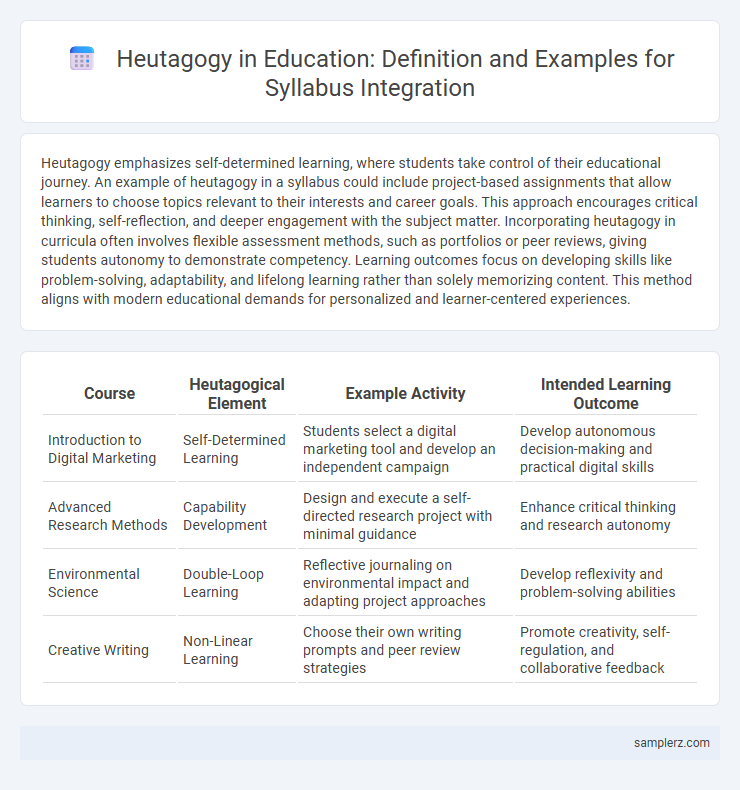Heutagogy emphasizes self-determined learning, where students take control of their educational journey. An example of heutagogy in a syllabus could include project-based assignments that allow learners to choose topics relevant to their interests and career goals. This approach encourages critical thinking, self-reflection, and deeper engagement with the subject matter. Incorporating heutagogy in curricula often involves flexible assessment methods, such as portfolios or peer reviews, giving students autonomy to demonstrate competency. Learning outcomes focus on developing skills like problem-solving, adaptability, and lifelong learning rather than solely memorizing content. This method aligns with modern educational demands for personalized and learner-centered experiences.
Table of Comparison
| Course | Heutagogical Element | Example Activity | Intended Learning Outcome |
|---|---|---|---|
| Introduction to Digital Marketing | Self-Determined Learning | Students select a digital marketing tool and develop an independent campaign | Develop autonomous decision-making and practical digital skills |
| Advanced Research Methods | Capability Development | Design and execute a self-directed research project with minimal guidance | Enhance critical thinking and research autonomy |
| Environmental Science | Double-Loop Learning | Reflective journaling on environmental impact and adapting project approaches | Develop reflexivity and problem-solving abilities |
| Creative Writing | Non-Linear Learning | Choose their own writing prompts and peer review strategies | Promote creativity, self-regulation, and collaborative feedback |
Integrating Heutagogy into Modern Syllabi
Integrating heutagogy into modern syllabi involves designing learner-centered modules that promote self-determined learning and critical thinking skills. Examples include project-based assessments, reflective journals, and personalized learning paths that encourage students to take ownership of their educational journey. This approach enhances adaptability and lifelong learning, aligning with the evolving demands of 21st-century education.
Heutagogical Strategies in Course Design
Heutagogical strategies in course design emphasize learner autonomy by integrating self-directed projects, reflective journaling, and personalized learning pathways within the syllabus. These approaches foster critical thinking and adaptability by allowing students to choose topics, set learning goals, and engage in problem-solving activities relevant to their interests. Incorporating digital portfolios and peer collaboration further supports metacognitive skills and continuous knowledge construction.
Real-World Applications of Heutagogy
Incorporating heutagogy in syllabus design emphasizes self-determined learning through real-world project-based assignments that require students to identify problems, set learning goals, and apply interdisciplinary knowledge. Examples include community-based research projects, entrepreneurial ventures, and collaborative digital content creation that foster critical thinking and adaptability. These activities cultivate learner autonomy, reflective practice, and the ability to navigate complex, authentic scenarios beyond traditional classroom boundaries.
Flexible Learning Paths in the Syllabus
Flexible learning paths in the syllabus embody heutagogy by empowering students to customize their educational journey according to individual interests and learning paces. This approach integrates project-based assessments, optional modules, and self-directed research tasks that promote autonomy and critical thinking. By incorporating adaptable deadlines and diverse learning resources, the syllabus supports personalized progress and lifelong learning skills.
Self-Directed Learning Projects
Self-directed learning projects in heutagogy emphasize student autonomy by allowing learners to design, implement, and assess their own research topics or skill development goals. This approach fosters critical thinking, problem-solving, and intrinsic motivation, aligning with heutagogical principles that prioritize learner agency and capacity building. Incorporating reflective journals and peer feedback within the syllabus enhances metacognitive skills and continuous self-improvement.
Student-Created Assessment Methods
Student-created assessment methods empower learners to design their own evaluation criteria and tools, fostering deeper engagement and ownership of the learning process. Incorporating reflective journals, peer reviews, and self-assessment portfolios in the syllabus encourages metacognitive skills and personalized learning paths. These approaches align with heutagogical principles by promoting learner autonomy and adaptability in educational environments.
Collaborative Knowledge Construction
Heutagogy in syllabus design emphasizes Collaborative Knowledge Construction by fostering learner autonomy and co-creation of content through group projects and peer-to-peer feedback sessions. Structured activities encourage students to jointly explore concepts, question assumptions, and develop critical thinking skills, enhancing deeper engagement with the material. Digital platforms and collaborative tools such as wikis and discussion forums support iterative knowledge building and shared responsibility for learning outcomes.
Technology-Enhanced Heutagogical Tools
Technology-enhanced heutagogical tools, such as adaptive learning platforms and interactive e-portfolios, empower students to take control of their learning by customizing content and tracking progress in real-time. These tools facilitate self-determined learning by providing immediate feedback and allowing learners to set personalized goals aligned with their interests and career aspirations. Integrating virtual simulations and collaborative online environments further enhances critical thinking and problem-solving skills, essential components of heutagogy in modern education.
Reflection and Metacognition Activities
Heutagogy in syllabus design incorporates reflection and metacognition activities such as learning journals, self-assessment tasks, and critical incident analyses to promote learner autonomy and deep understanding. These activities encourage students to evaluate their cognitive processes, adapt learning strategies, and foster lifelong learning skills. Embedding structured reflection prompts and metacognitive questions within course modules enhances self-regulated learning and improves academic outcomes.
Fostering Agency Through Heutagogy
Including heutagogy in a syllabus empowers students to take control of their learning by encouraging self-directed study and critical reflection. Assignments that require learners to set personal goals, choose resources, and evaluate their progress foster deep metacognitive skills and enhance learner agency. This approach integrates flexible content delivery with collaborative projects, promoting autonomy and lifelong learning competencies essential in modern education.

example of heutagogy in syllabus Infographic
 samplerz.com
samplerz.com